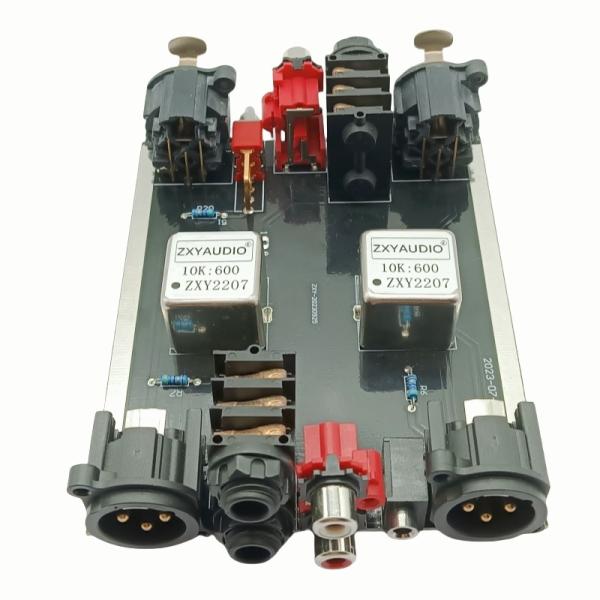| Sign In | Join Free | My chinacomputerparts.com |
|
| Sign In | Join Free | My chinacomputerparts.com |
|
| Categories | Audio Isolator |
|---|---|
| Brand Name: | ZXY |
| Model Number: | ZXY2207 10K:600 |
| Certification: | RoHS,ISO9001,CE |
| Place of Origin: | Shenzhen,China |
| MOQ: | Negotiable |
| Price: | Negotiable |
| Payment Terms: | T/T ,paypal transfer |
| Supply Ability: | 1000K-pcs/month |
| Delivery Time: | 2-3 weeks |
| Packaging Details: | 100pieces / Carton; Size:380mm*325mm*345mm |
| Model number: | ZXY2207 10K:600 |
| Product name: | 2207 10K:600 Audio Isolator |
| Usage: | Radio station |
| Characterization: | Electrical isolation characteristics |
| Strong point: | Improve audio signal quality |
| Supplier: | Manufacturer |
| Company Info. |
| Shenzhen Zhixiangyuan Electronics Co., Ltd. |
| Verified Supplier |
| View Contact Details |
| Product List |
10K: 600 Audio Isolator refers to an audio isolator with a conversion ratio of 10K (10000 ohms) to 600 ohms, mainly used for audio signal processing, achieving electrical isolation while maintaining audio signal integrity. The following introduces the specifications, working principles, characteristics, and application scenarios:
1.10K and 600: These two numbers represent the impedance values of the primary and secondary of the audio isolator. 10K (10000 ohms) is usually the impedance of the primary winding, while 600 ohms is the impedance of the secondary winding. This specific impedance ratio design enables audio isolators to achieve good matching between audio devices with different impedance characteristics, ensuring efficient transmission and optimal performance of audio signals.
2. Impedance matching function: In audio systems, the impedance of
source devices (such as microphones and audio players) and load
devices (such as amplifiers and speakers) need to be matched with
each other to achieve maximum power transmission and minimum signal
reflection. A 10K:600 impedance ratio helps connect high impedance
audio sources to low impedance loads, or vice versa, optimizing the
transmission of audio signals between different devices, reducing
signal loss and distortion.
10K: 600 Audio Isolator mainly works based on the principles of electromagnetic induction and impedance transformation, as follows:
1. Electromagnetic induction principle - primary winding generates
magnetic field/secondary winding generates induced electromotive
force/electrical isolation implementation
2. Impedance transformation principle
--Impedance matching function: The impedance ratio of 10K:600
determines the matching function of the audio isolator between
different impedance devices. In an audio system, the impedance of
the source and load devices needs to be matched to achieve maximum
power transmission and minimum signal reflection. When a high
impedance audio source is connected to the 10K primary winding of a
10K:600 Audio Isolator, electromagnetic induction is used to output
signals in the 600 ohm secondary winding, which can be adapted to
low impedance load devices, and vice versa, thereby optimizing the
transmission of audio signals between different devices and
reducing signal loss and distortion.
--Signal transmission optimization: According to Ohm's law, the
relationship between voltage and current will change under
different impedance environments. The audio isolator adjusts the
voltage and current ratio of the signal through a specific
impedance ratio, enabling the audio signal to better adapt to the
input and output requirements of different devices during
transmission, ensuring that the amplitude, frequency response,
phase and other characteristics of the signal are not significantly
affected during transmission, and maintaining the integrity of the
audio signal.
| Electrical Characteristics | Details |
| Impedance Ratio | - Primary Impedance: 10,000 ohms (10K). This is designed to interface with high - impedance audio sources. |
| - Secondary Impedance: 600 ohms. It can be easily connected to low - impedance audio loads, enabling impedance matching between different audio devices. | |
| Frequency Response | - Typically covers a wide frequency range, usually from 20 Hz to 20 kHz. This ensures faithful reproduction of the entire audible frequency spectrum, from deep bass to high - pitched treble. The deviation within this frequency range is generally kept within a very small margin, for example, 卤0.5 dB, which means the audio signal maintains a consistent amplitude across the frequencies. |
| Insertion Loss | - Low insertion loss, usually in the range of 0.5 - 1 dB. This indicates that only a small amount of signal power is lost as the audio signal passes through the isolator. A lower insertion loss value is desirable as it ensures more of the original audio signal's power is transferred to the output, resulting in a stronger and clearer audio output. |








|